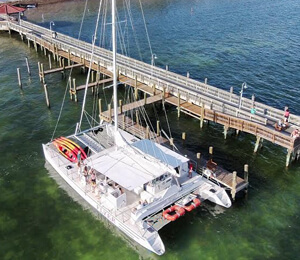Key West and the surrounding areas are full of history. You can visit the pirate museum or see Hemmingway's six-toed cats. For such a small island, it's large on history. But if you're a history buff visiting Key West, you may want to venture a bit off the beaten path. Hop a ferry to Dry Tortugas National Park and you can spend the day exploring a nearby historic site, Fort Jefferson. With a long and varied history, Fort Jefferson is sure to hold your attention and you may just get in a little Key West scuba diving or a snorkel Key West while you visit the park.
Traveling To Fort Jefferson
Fort Jefferson is part of Dry Tortugas National Park. Known as one of the most remote parks of the National Park System, the Dry Tortugas are only accessible by boat. Private boats are not allowed in the park, so you'll need to take a ferryboat leaving from Key West. The trip is 70 miles by boat, but you're sure to enjoy the ride. Each charter boat has its own niche, so explore your options. Some offer meals aboard, some promise dolphin watching, and others stop for Key West snorkeling. BestOnKeyWest.com can give you a little insight into the different possibilities or you can always check with the concierge at your Key West hotel.
Fort Jefferson And Its History
The Dry Tortugas National Park is made up of seven small islands. Fort Jefferson is located on Garden Key and is uninhabited, but that wasn't always the case. Construction began on Fort Jefferson in 1846 when Commodore John Rodgers decided that it was imperative for the United States to have an "advance post" for defending the Gulf Coast and U.S. shipping interests from hostile powers.
Fort Jefferson is the largest masonry structure in the Western Hemisphere, composed of over 16 million bricks! Fort Jefferson was designed to be a gigantic gun platform that would be capable of destroying any enemy ships that came within range of its powerful weapons. The Army hired civilian machinists, blacksmiths, masons, carpenters, and general laborers to build Fort Jefferson. Slaves were also used to construct the fort. Fort Jefferson served as an Army prison and by 1863, the slaves were no longer needed, as the prisoner population was sufficient to do the job.
Fort Jefferson's population peaked at 1,729, but with the end of the Civil War, the population declined to just over 1,000 with an even split between soldiers and prisoners. Most of the prisoners were soldiers who were convicted of desertion, but in 1865 the prison also housed the men convicted of conspiracy in the assassination of President Lincoln.
Fort Jefferson, still not completed was turned over to the Marine Hospital Service to serve as a quarantine station in 1888.
Fort Jefferson Becomes A National Historic Place
In 1935, President Franklin D. Roosevelt designated Fort Jefferson as a National Monument and it was listed on the National Register of Historic Places in 1970. Today, you can visit Fort Jefferson and relive the history through self-guided tours. The fort is currently under restoration. From November to May, certain parts of Fort Jefferson may be closed while the masons work on the structure. You can visit the National Park Service website for more details as you plan your historic trip.

